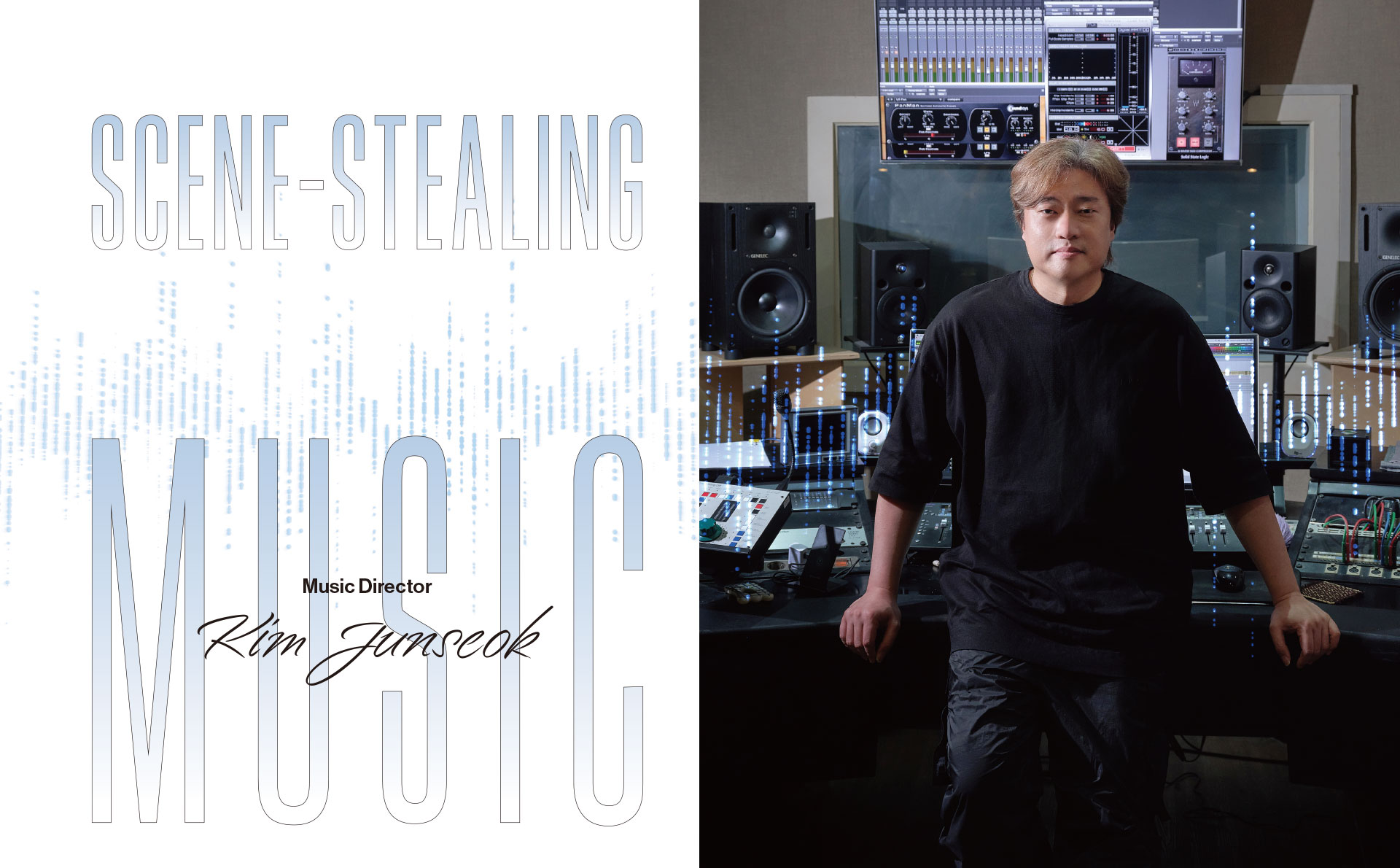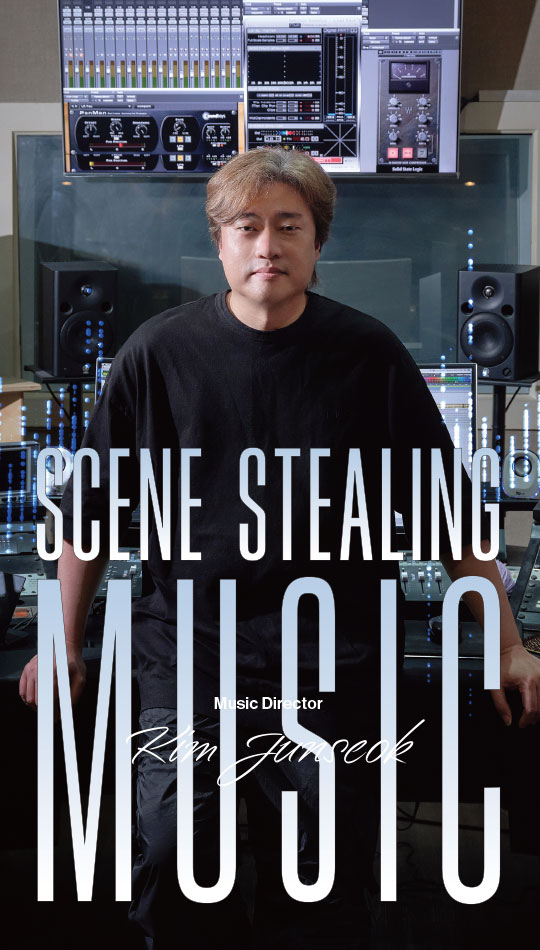A film’s score is a key part of conveying characters’ feelings and predicaments. A score does more than fill in the background―it can make a film shine. And one of the most talented score composers today is music director Kim Junseok, who has worked on a wide range of both films (including “Once Upon a Time in High School,” “Speed Scandal,” “Hello Ghost,” “Sunny,” “Unbowed,” “Tazza: The Hidden Card” and “Swing Kids”) and TV shows (including “Misaeng: Incomplete Life,” “Signal,” “Stranger,” “My Mister” and “The Glory”).


Writer. Sung Ji Yeon
Discovering the Dream
Kim Junseok first got into music by playing the bass guitar for a band. But the moment that launched his career as a musician came after the band broke up while he was trying to decide which career to pursue. That was when an older student suggested he try his hand at film scores.
Movie scores were unfamiliar territory for Kim, who knew little about music and even less about directing movies or writing scores. That ignorance was a hurdle he had to clear before trying out that line of work. His first step toward learning about movie scores was watching loads of movies. He asked around for movie recommendations and, after viewing each one, jotted down his impressions about the movie and its score. He also got into composing music on his computer. He saved up money for the basic equipment and learned the functions one button at a time. Kim also took music classes and got help from his colleagues when he was stumped. As he learned about musical instruments’ capabilities and the meaning of a good performance, he gradually became enthralled with music in the movies.
The day his first music was released to the world was the day he discovered his dream in life. “When the film was over the moment my name showed up, I thought my heart would burst. Having that kind of experience made me even more determined to dedicate myself to film scores. It was the first time I’d found a definite direction for my life.”

For a Better Film
Since becoming a music director, Kim has supercharged numerous films with his intriguing motifs. Most of the music in “Once Upon a Time in High School,” set in 1978, is primarily played on the acoustic guitar, which was trendy at the time. “Tazza: The Hidden Card” is about gamblers from various parts of Korea gathering for one epic game, and Kim incorporated a similar narrative into his music―a journey from Brazil to a gambling hub like Las Vegas. The title track, featuring Brazilian instrument known as the cuica, was especially popular with audiences.
Film music has also brought Kim some unforgettable thrills. There was a tough scene in “Tazza: The Hidden Card” he finally figured out thanks to Hwatu, the Korean card game played in the film. “It was a scene where tensions were running high between the characters, and I was experiencing terrible writer’s block. I’d been up all night, and inspiration finally struck at 9 a.m. That’s when it occurred to me that in a film about Hwatu, I ought to try Hwatu cards. By shuffling them, scraping them together and slapping them down, I came up with percussive sounds. I got so excited I kept working through the evening. That’s how I finished the song ‘The Match Between Jang Dong-sik and Dae-gil.’”
As a film veteran, with 26 years under his belt now, how would Kim define a music director? “It’s the person who produces a film in the medium of music,” he said. That raises the question of what it means to approach music not as a musician but as a director. “The first step is analyzing the scene. Smiling doesn’t always mean someone is happy, and crying doesn’t always mean they’re sad, right? The music director needs to understand the actor’s emotions in a specific scene, as well as that scene’s tempo in the context of the entire movie.”
Kim sometimes has to put on an actor’s hat to better understand a given scene. He’ll recite lines and imitate facial expressions to dive into a character’s psychology. He’s also always in touch with the director to grasp the thought process behind a scene’s inclusion in the film.
One important consideration for Kim is making sure the music doesn’t drown out the actors’ lines or distract viewers from the film. “One time, I watched a film that a famous composer had worked on. The music was so great and absorbing that I lost track of the scene. So there are a lot of things the music director has to bear in mind: the emotions of the characters, the pacing of the film, the intentions of the director and the appropriateness of the music. You need to have an ongoing dialogue with the director until the curtain goes down.”
 Albums featuring original soundtracks from films and dramas that director Kim Junseok has worked on
Albums featuring original soundtracks from films and dramas that director Kim Junseok has worked on
Paying it Forward
Kim takes music seriously because of how grateful he feels to cinema. Movies only last a couple of hours, but they let him experience other people’s lives and feel an incredible range of emotions. Movies have also determined so many aspects of his life. Considering everything Kim owes to the movies, he wants to give a little back.
“COVID-19 was a big blow for the Korean film industry, and musicians are being threatened by artificial intelligence. No doubt, we’ll find a way to overcome all that, but for now, I just want people in film and music to be happy. I can’t be there for everyone, but I’d like to do what I can for the cinephiles and musicians I know.”
Kim talks about his work with an ingenuous enthusiasm, but he’s all business when he speaks as a member of the film industry. I suppose that’s the attitude of someone with a genuine passion for both music and movies. His work has benefited both, helping some to better appreciate films and encouraging others to stick to the path of music. That’s why I hope he’ll keep adorning the silver screen with his stirring songs. His latest music can be seen in the current TV series “Connection” and “The Player 2: Master of Swindlers” and the upcoming film “Hi.5.”
